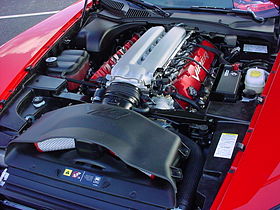This article needs additional citations for verification. (November 2014) |
| Viper engine | |
|---|---|
 The Viper engine on the ZB I version of the Viper. | |
| Overview | |
| Manufacturer | |
| Production | 1992–2010 2012–2017 |
| Layout | |
| Configuration | Naturally-aspirated 90° V10 |
| Displacement |
|
| Cylinder bore |
|
| Piston stroke |
|
| Cylinder block material | Aluminum |
| Cylinder head material | Aluminium |
| Valvetrain | OHV 2 valves per cylinder with VVT (2008+ models) |
| Compression ratio | 9.6:1, 10.2:1 |
| Combustion | |
| Fuel system | Multi-port fuel injection |
| Fuel type | Gasoline |
| Oil system | Wet sump |
| Cooling system | Water cooled |
| Output | |
| Power output |
|
| Torque output |
|
| Dimensions | |
| Dry weight |
|
The Viper engine is a high-performance naturally-aspirated pushrod 2 valve-per-cylinder 90° V10 engine designed by Chrysler but with aluminum block castings designed by Lamborghini for use in the Dodge Viper. Despite its large displacement, it is based on the Chrysler LA V8.[1]
- ^ Scherr, Elana (2014-06-26). "How The Viper Engine Got Its Horsepower". MotorTrend. Archived from the original on 2022-04-07. Retrieved 2023-05-12.